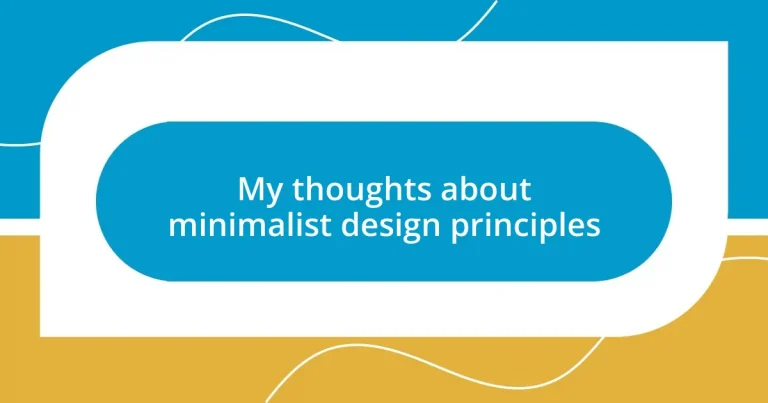Key takeaways:
- Minimalist design emphasizes functionality, simplicity, and the importance of open spaces to create serene environments.
- Essential elements include a limited color palette, quality over quantity, and clean lines that promote tranquility and focus.
- Adopting minimalist principles can enhance productivity, clarity, and appreciation for meaningful possessions.
- Common mistakes include creating overly cold spaces, over-complicating functionality, and neglecting the scale of objects.
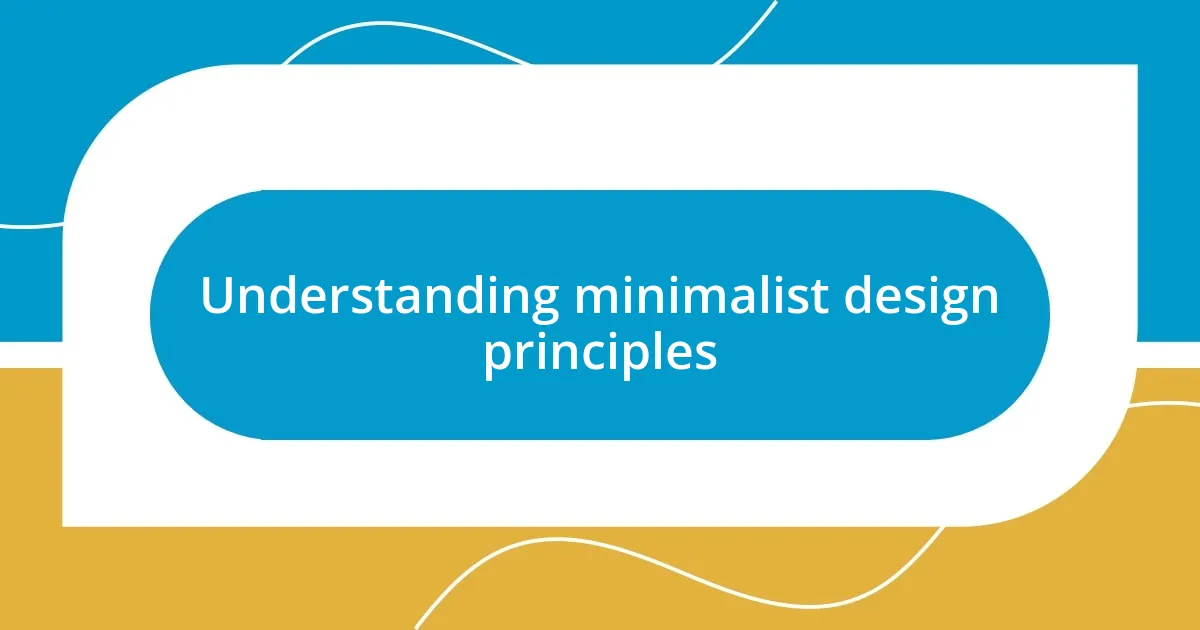
Understanding minimalist design principles
Minimalist design principles focus on the idea that less is more. When I first embraced this concept, I felt an overwhelming sense of clarity in my surroundings. Removing unnecessary clutter—both visually and mentally—allowed me to appreciate the beauty of simplicity in everyday objects. Have you ever noticed how a clean, open space can instantly elevate your mood?
At the heart of minimalist design is the belief that every element should serve a purpose. I remember redesigning my workspace and carefully selecting only items that inspired creativity and productivity. It was fascinating to see how each piece contributed to a harmonious whole, as if they were in conversation with one another. Have you ever experienced this kind of synergy in your own space?
Furthermore, minimalist design often emphasizes functionality alongside aesthetics. During a recent project, I opted for furniture that didn’t just look good but also enhanced my lifestyle. This choice resonated with me deeply, proving that design goes beyond visual appeal—it’s about creating an environment that truly supports our needs and values. Isn’t that an empowering insight into what design can achieve?
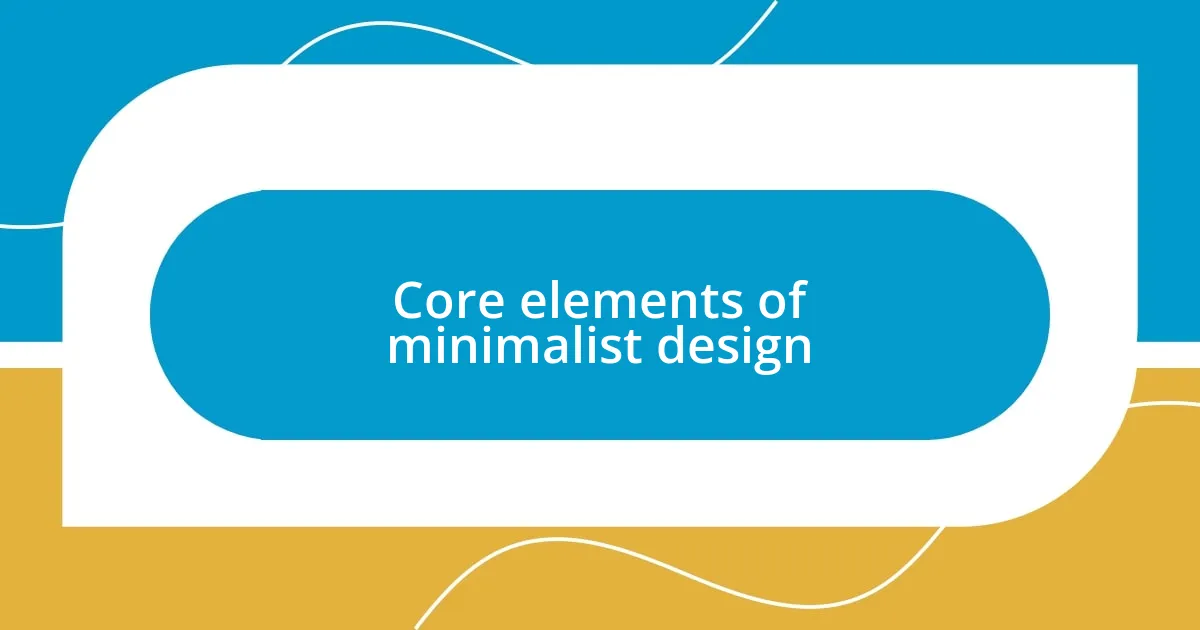
Core elements of minimalist design
When considering the core elements of minimalist design, I find that simplicity truly brings focus. It’s about stripping away the non-essential to highlight what matters. I still remember when I opted for a single, elegant lamp in my living room instead of multiple lighting sources. It not only illuminated the space beautifully but also became a conversation starter, demonstrating how one well-chosen item can have such impact.
Here are some essential aspects of minimalist design:
- Functionality: Every piece should have a purpose, ensuring that it contributes to the overall experience.
- Open Space: Emphasizing negative space fosters a sense of calm and allows the eye to rest, creating a more inviting atmosphere.
- Limited Color Palette: Using a restrained selection of colors creates a cohesive look that enhances the feeling of tranquility.
- Quality over Quantity: Investing in fewer, higher-quality items leads to a more thoughtful and lasting design.
- Clean Lines and Shapes: Simple geometries provide an understated elegance that draws the eye without overwhelming it.
These elements resonate with me because I’ve seen firsthand how they transform spaces, making them not just visually appealing but also emotionally nurturing.
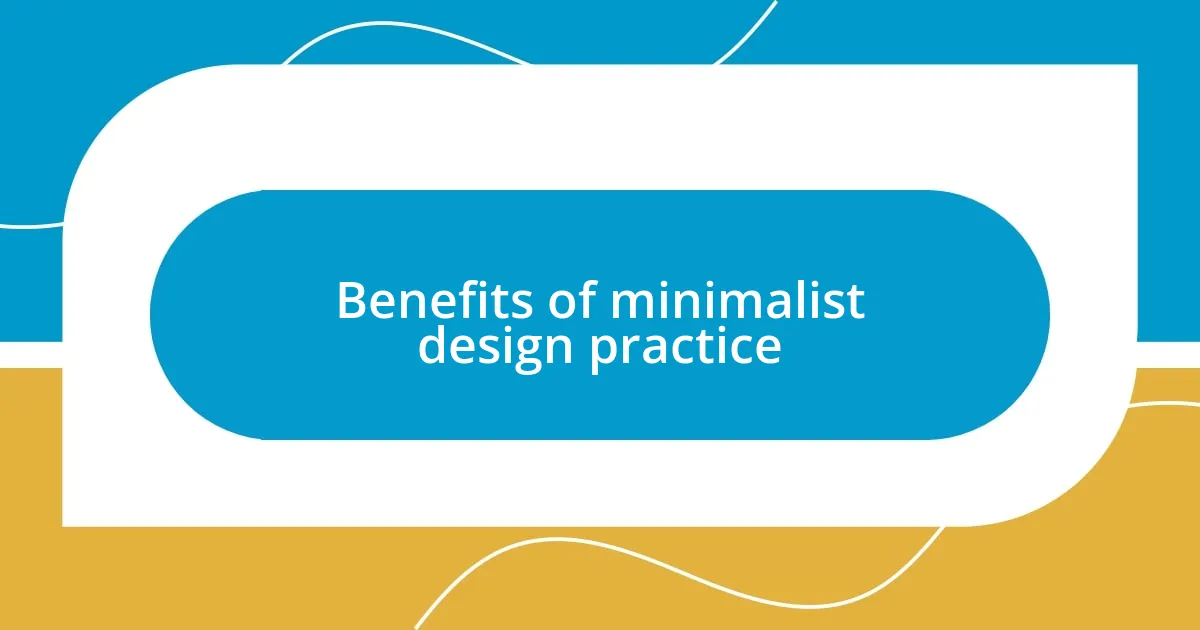
Benefits of minimalist design practice
Adopting minimalist design principles can have a profound impact on both your environment and your state of mind. I remember the first time I transitioned to a minimalist approach in my kitchen. By clearing out unnecessary gadgets and prioritizing multifunctional tools, I not only streamlined my cooking process but also discovered joy in the simplicity of meal preparation. Isn’t it interesting how an uncluttered space can also lead to an uncluttered mind?
Another benefit of minimalist design lies in its ability to enhance productivity. I once changed my office layout to reflect this principle, removing distractions to create a focused workspace. The result was remarkable; I found myself completing tasks more efficiently and even sparking new ideas. Doesn’t it feel empowering to know that a thoughtfully designed environment can directly influence your creativity and effectiveness?
Lastly, minimalism encourages deeper connections with the objects around us. By surrounding myself with fewer, yet more meaningful items, I’ve developed a sense of appreciation I hadn’t before. One particular piece—a striking painting—sits proudly on my wall, inviting contemplation daily. Have you ever considered how fewer possessions might affect your connection to what truly matters in your life?
| Benefit | Description |
|---|---|
| Clarity | Eliminates distractions to create a serene environment. |
| Productivity | Enhances focus and efficiency by minimizing clutter. |
| Connection | Fosters appreciation for meaningful items in our lives. |
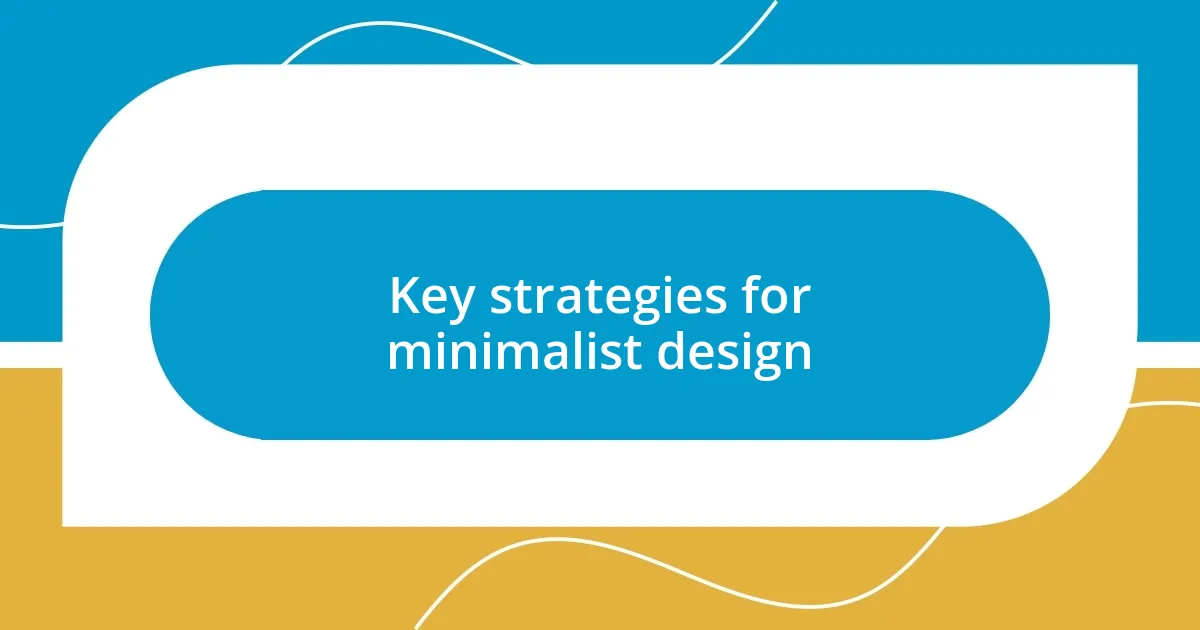
Key strategies for minimalist design
One key strategy in minimalist design is to prioritize functionality in every choice we make. I remember revamping my workspace by selecting tools that serve multiple purposes. This intentionality not only cleared out unnecessary clutter but also transformed my efficiency; I was amazed at how much smoother my workflow became. Have you ever thought about how the functionality of your items could enhance your daily routine?
Another effective approach is embracing open spaces, which I’ve found vital in creating a calm atmosphere. In my own living room, removing excess furniture generated a free-flowing environment that felt inviting. It’s fascinating how this negative space offers the mind a breather, encouraging relaxation or inspiration. Doesn’t it feel refreshing to let your eyes relax without the chaos of overcrowded decor?
Lastly, I advocate for a limited color palette in minimalist design. When I painted my bedroom in soft, muted tones, it completely altered the vibe of the space. The subtlety promotes tranquility and makes my sanctuary feel like a true retreat. How do you think color influences your mood and perception of space?
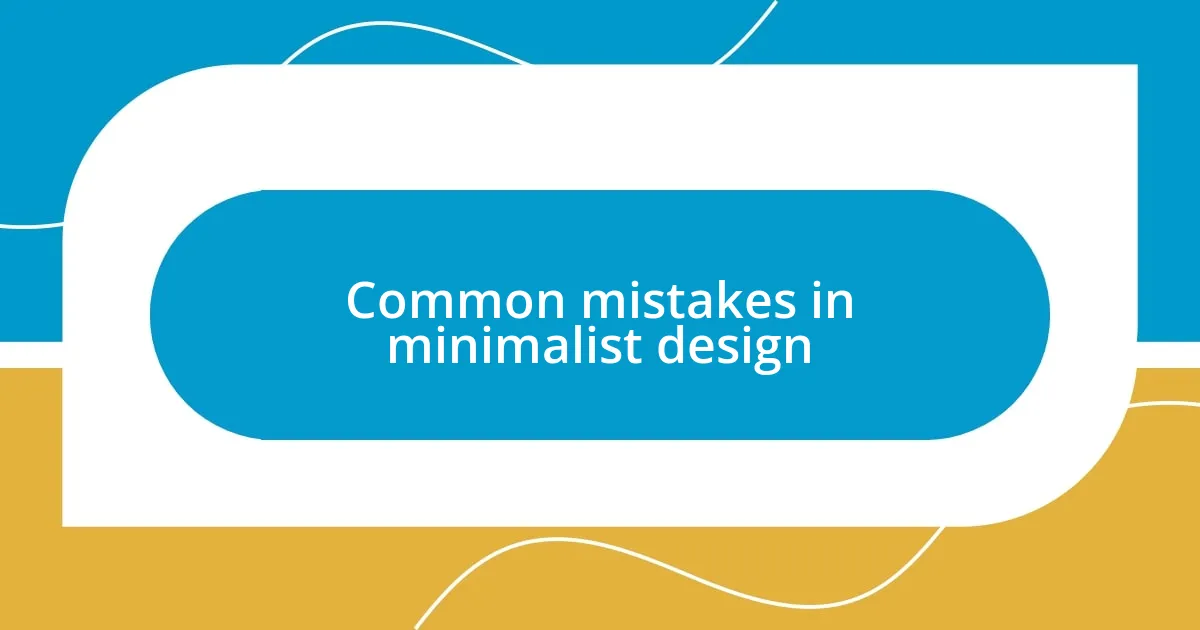
Common mistakes in minimalist design
One common mistake I often see in minimalist design is the temptation to strip down spaces to the point where they feel cold or uninviting. I’ve visited homes where the absence of personal touches made me feel like I was in a gallery rather than a living area. Isn’t it paradoxical that in trying to simplify, some forget to add warmth through personal elements like photos or sentimental items?
Another error I’ve encountered is over-complicating functionality. There was a time when I thought I could combine too many functions into one piece of furniture—like a coffee table with storage, a desk, and a dining table all rolled into one. The result? A bulky piece that fell short on all its promises. How often do we mistake complexity for innovation, only to create more confusion?
Lastly, neglecting the importance of scale can undermine minimalist intentions. I recall mistakenly placing a huge piece of art in a small room, which overwhelmed the space rather than complementing it. Have you ever considered how the size of objects in your space can either elevate or detract from its intended simplicity?
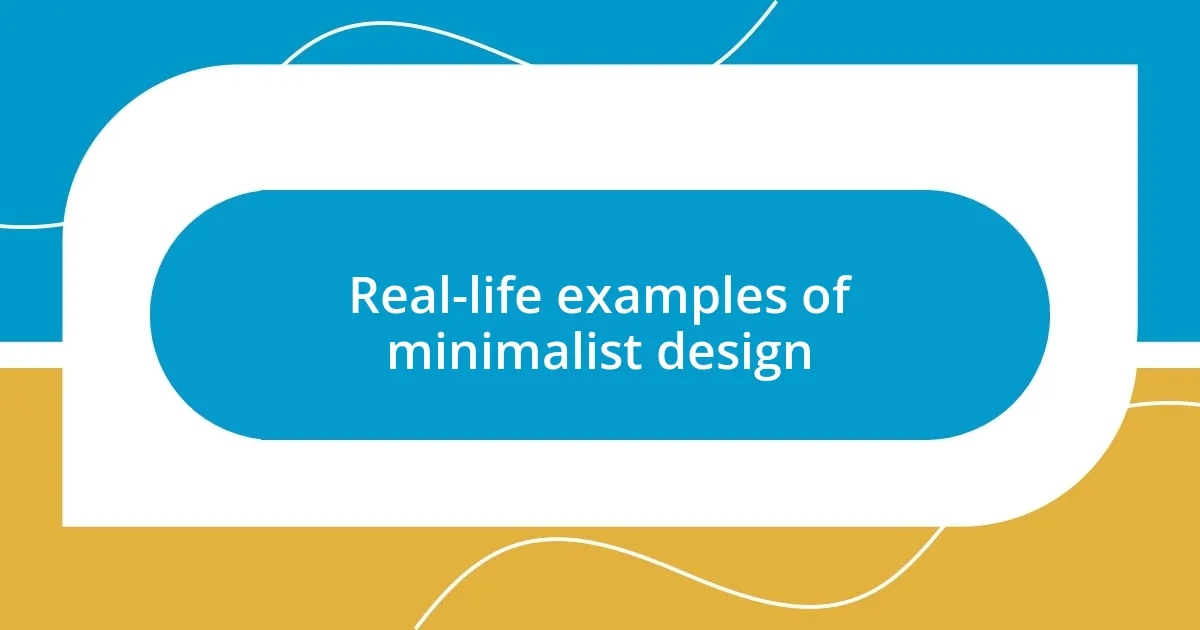
Real-life examples of minimalist design
When I think of minimalist design in real life, I can’t help but recall the iconic Apple store. Walking in, the open layout, the sleek lines of the products, and the abundance of natural light create a stunning visual harmony. It’s inspiring how their design prioritizes the experience of the consumer, allowing the beautifully crafted devices to take center stage. Have you ever noticed how a well-designed space can elevate an ordinary product into something extraordinary?
In my travels, I stumbled upon a breathtaking café in Kyoto that embodies minimalist principles beautifully. The wooden beams, coupled with carefully chosen plants, invited a serene ambiance that felt like a retreat from the bustling city outside. I remember sitting there, sipping tea, appreciating how the thoughtful simplicity encouraged me to savor the moment instead of rushing through it. Isn’t it incredible how design can manipulate our mood and behavior?
Another striking example is the tiny house movement, where minimalism isn’t just a style but a philosophy. I once attended a workshop where they showcased tiny homes, each ingeniously designed to maximize space and functionality. The creativity required to make every inch count was astonishing! It made me think: what if we all embraced minimalism not just in our homes but in our lives? How would that change our daily interactions and our mental space?












